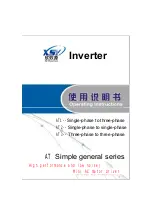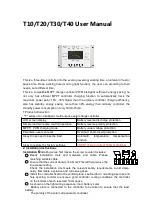
16
100238
ENGLISH
OPERATION
Do Not Overload Generator
Capacity
Follow these simple steps to calculate the running and starting
watts necessary for your purposes.
1. Select the electrical devices you plan on running at the
same time.
2. Total the running watts of these items. This is the amount
of power you need to keep your items running.
3. Identify the highest starting wattage of all devices
identified in step 1. Add this number to the number
calculated in step 2. Surge wattage is the extra burst of
power needed to start some electric driven equipment.
Following the steps listed under “Power Management” will
guarantee that only one device will be starting at a time.
Power Management
Use the following formula to convert voltage and amperage to
watts:
Volts x Amps = Watts
To prolong the life of your generator and attached devices,
follow these steps to add electrical load:
1. Start the generator with no electrical load attached
2. Allow the engine to run for several minutes to stabilize.
3. Plug in and turn on the first item. It is best to attach the
item with the largest load first.
4. Allow the engine to stabilize.
5. Plug in and turn on the next item.
6. Allow the engine to stabilize.
7. Repeat steps 5-6 for each additional item.
Never exceed the specified capacity when adding
loads to the generator.
NOTE
Operation using the alternative main jet at
elevations lower than the recommended minimum
altitude can damage the engine. For operation at
lower elevations, the standard main jet must be
used. Operating the engine with the wrong engine
configuration at a given altitude may increase
its emissions and decrease fuel efficiency and
performance.
WARNING
Stopping the Engine Cont’d.
Operation at High Altitude
The density of air at high altitude is lower than at sea
level. Engine power is reduced as the air mass and air-
fuel ratio decrease. Engine power and generator output
will be reduced approximately 3½% for every 1000
feet of elevation above sea level. This is a natural trend
and cannot be changed by adjusting the engine. At high
altitudes increased exhaust emissions can also result
due to the increased enrichment of the air fuel ratio.
Other high altitude issues can include hard starting,
increased fuel consumption and spark plug fouling.
To alleviate high altitude issues other than the natural
power loss, Champion Power Equipment can provide a
high altitude carburetor main jet. The alternative main
jet and installation instructions can be obtained by
contacting Customer Support. Installation instructions
are also available in the Technical Bulletin area of the
Champion Power Equipment internet site.
The part number and recommended minimum altitude
for the application of the high altitude carburetor main
jet is listed in the table below.
In order to select the correct high altitude main jet
it is necessary to identify the carburetor model. For
this purpose, a code is stamped on the side of the
carburetor. Select the correct main jet part number
corresponding to the carburetor code found on your
particular carburetor.
Stopping the Engine
1. Turn off and unplug all electrical loads. Never start
or stop the generator with electrical devices plugged
in or turned on.
2. Let the generator run at no-load for several minutes
to stabilize internal temperatures of the engine and
generator.
3. Turn the gasoline fuel valve to the “OFF” position if
operating by gasoline.
4. Turn the LPG cylinder knob to the “CLOSE” or “OFF”
position if operating by LPG.
5. Let the engine run until fuel starvation has stopped
the engine. This usually takes a few minutes.
6. Press the ignition switch to the “OFF” position.
7. Turn battery switch to the “Off” Position.
Important: Always ensure that the Fuel Valve and the
Ignition Switch are in the “OFF” position when the
engine is not in use.
When turning off the generator after LPG operation, make
sure the LPG cylinder knob is in the fully closed position.
NOTE
If the engine will not be used for a period of two (2) weeks
or longer, please see the Storage section for proper engine
and fuel storage.
NOTE
Carburetor
Code
Main Jet
Part Number
Altitude
P22-4-H
Standard
27.131017.01.H
3500 Feet
(1067 Meters)
Altitude
27.131017.01.01.H
P22-4-Z
Standard
27.131017.01.Z
Altitude
27.131017.01.01.Z















































